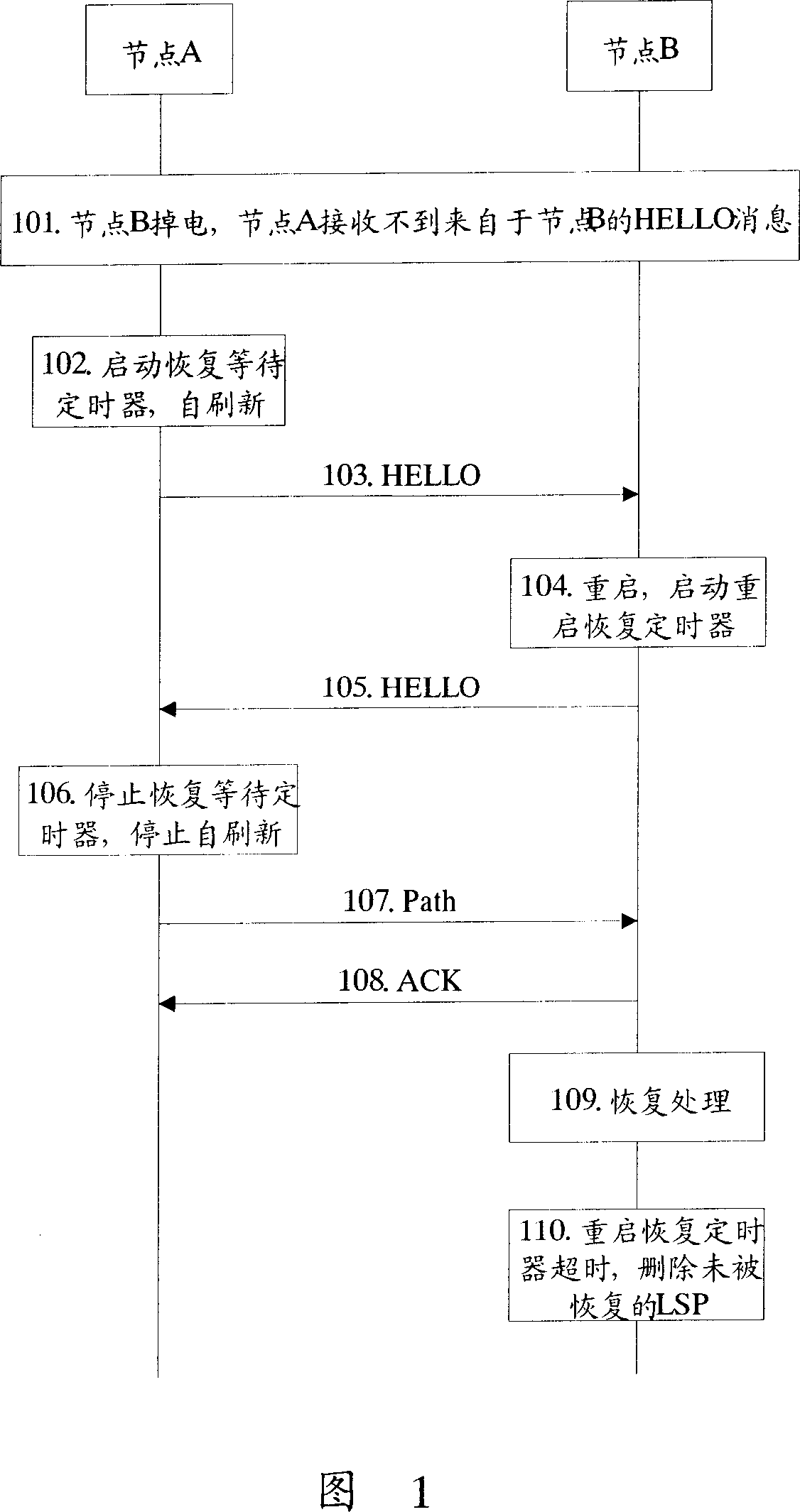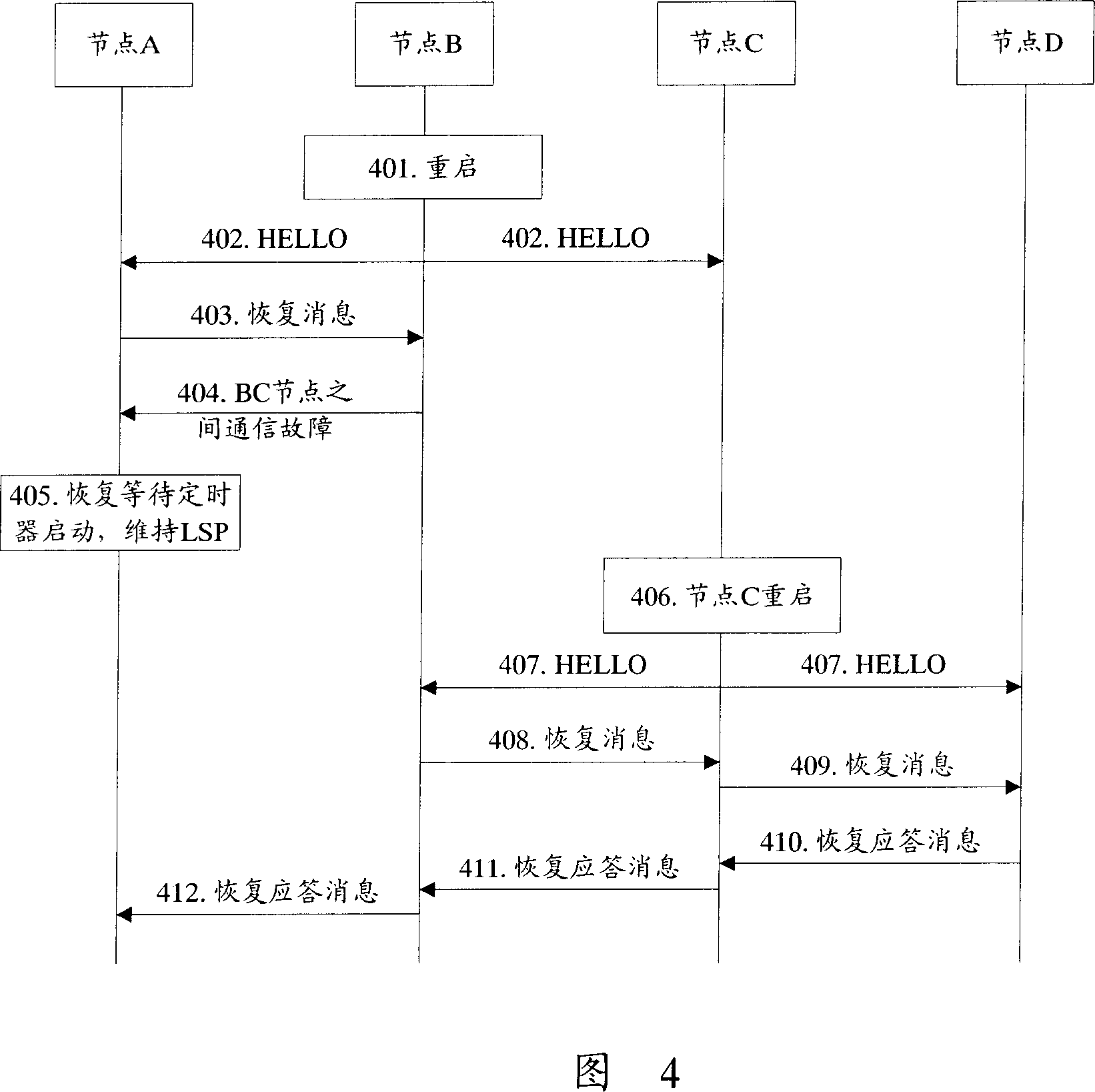A processing method for multi-node communication failure
A technology for communication faults and processing methods, which is applied to the selection device of multiplexing systems, digital transmission systems, electrical components, etc., and can solve problems such as affecting transport plane services and failing to reliably restore LSPs.
- Summary
- Abstract
- Description
- Claims
- Application Information
AI Technical Summary
Problems solved by technology
Method used
Image
Examples
Embodiment 1
[0102] In this embodiment, an LSP passing through nodes A, B, C, and D in sequence is taken as an example for illustration. Fig. 3 shows a schematic diagram of the running status of nodes on the LSP path in this embodiment. As shown in FIG. 3 , Node B and Node C are powered off, and Node B restarts, and Node C fails to restart for a long time. Node B is the restart node, node C is the neighbor node of node B, node A is the normal node in the upstream direction closest to the restart node B, and node D is the normal node in the downstream direction closest to the restart node B. Here, according to mode 1, the recovery waiting time is set on the normal node closest to the restart node on the LSP path, that is, node A.
[0103] Fig. 4 shows a flow chart of the multi-node communication fault handling method in this embodiment. Referring to Figure 4, the method includes:
[0104] In steps 401-402, node B is powered on and restarted, sends a HELLO message to node A and node C, an...
Embodiment 2
[0121] In this embodiment, the LSP shown in FIG. 3 is still taken as an example, node B restarts, and node C fails to restart for a long time. Here, according to mode 2, the recovery waiting time is set on the restarting node, that is, node B, and the failure information of communication interruption is sent to node A.
[0122] Fig. 5 shows a flow chart of the multi-node communication fault handling method in this embodiment. Referring to Figure 5, the method includes:
[0123] In steps 501-502, node B is powered on and restarted, sends a HELLO message to node A and node C, and node B learns that node B and node C are in a communication failure state through the HELLO message mechanism.
[0124] Here, in the HELLO message sent by node B, the src-instance value is the value before power failure + 1, and the dst-instance value is 0, so that node A and node C know the restart of node B.
[0125] After node B sends a HELLO message to node C, it does not receive a response from n...
Embodiment 3
[0137] In this embodiment, the LSP shown in FIG. 3 is still taken as an example, node B restarts, and node C fails to restart for a long time. Here, according to mode 3, the recovery waiting time is set on the restarting node, that is, node B, and a normal recovery response message is constructed and sent to node A.
[0138] Fig. 6 shows a flow chart of the multi-node communication fault handling method in this embodiment. Referring to Figure 6, the method includes:
[0139] In steps 601-602, node B is powered on and restarted, sends a HELLO message to node A and node C, and node B learns that node B and node C are in a communication failure state through the HELLO message mechanism.
[0140] After node B sends a HELLO message to node C, it does not receive a response from node C to the HELLO message, so it is determined that the communication between node B and node C is interrupted. The cause of communication interruption between the two nodes may not only be that node C i...
PUM
 Login to View More
Login to View More Abstract
Description
Claims
Application Information
 Login to View More
Login to View More - R&D
- Intellectual Property
- Life Sciences
- Materials
- Tech Scout
- Unparalleled Data Quality
- Higher Quality Content
- 60% Fewer Hallucinations
Browse by: Latest US Patents, China's latest patents, Technical Efficacy Thesaurus, Application Domain, Technology Topic, Popular Technical Reports.
© 2025 PatSnap. All rights reserved.Legal|Privacy policy|Modern Slavery Act Transparency Statement|Sitemap|About US| Contact US: help@patsnap.com



